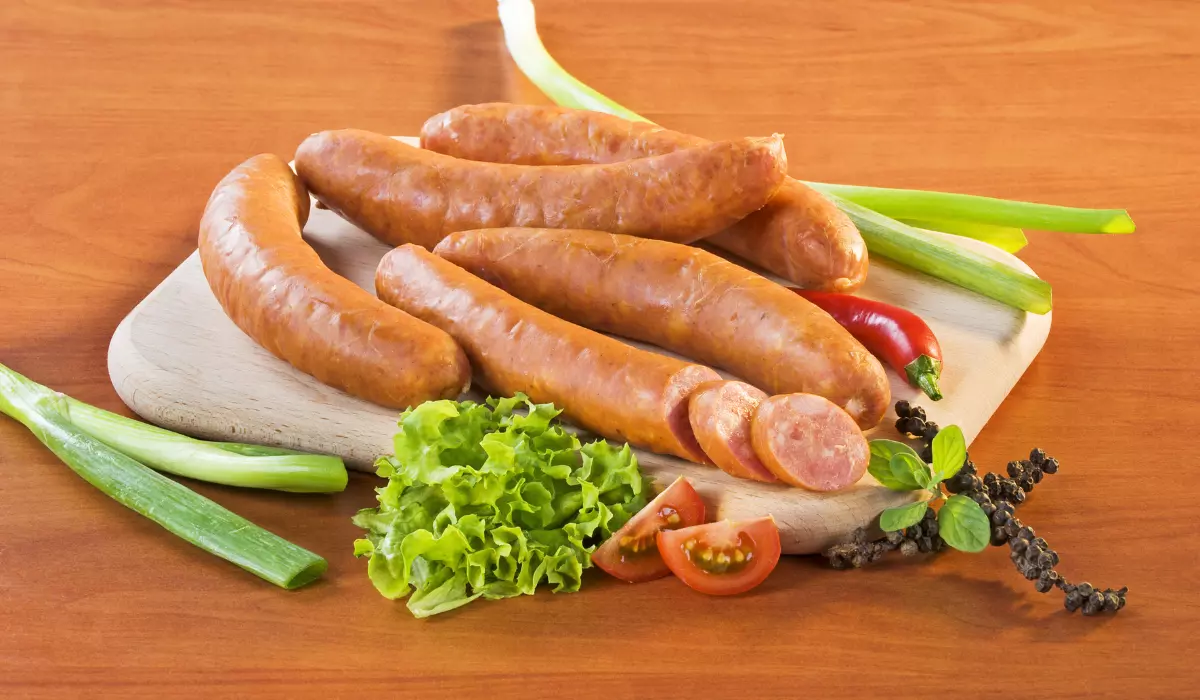Introduction to Kielbasa :
Kielbasa, a staple in Polish cuisine, has a rich history that spans several centuries. This traditional Polish sausage is known for its unique flavor and versatility in various dishes. Originating from Poland, kielbasa is not just a food item; it’s a cultural symbol, deeply embedded in Polish traditions and celebrations. The term “kielbasa” covers a wide range of sausages, each with its distinct taste and preparation method. From the smoky kielbasa lisiecka, a Protected Geographical Indication product, to the wedding favorite kielbasa weselna, these sausages are an integral part of Polish heritage. They are made from different meats like pork, beef, and turkey, adapting to regional preferences and dietary needs. The versatility of kielbasa makes it a beloved ingredient in many households, transcending its origins to become a global favorite.
For those interested in exploring more about healthy cooking methods, check out our guide on Air Fryer Kielbasa, which offers a quick and easy way to enjoy this delicious sausage.
Nutritional Profile of Kielbasa :
Understanding the nutritional profile of Polish sausage nutrition is crucial for those who enjoy this flavorful sausage as part of their diet. Polish sausage nutrition is a rich source of protein, an essential macronutrient vital for muscle building and repair. A typical serving contains a significant amount of protein, contributing to its popularity among fitness enthusiasts. However, it’s also important to note the fat content in kielbasa dietary facts. While it provides a satiating quality, the fat in kielbasa dietary facts, particularly saturated fat, should be consumed in moderation.
In terms of vitamins and minerals, Polish sausage nutrition is a noteworthy source of several key nutrients. It contains iron, essential for blood health, and Vitamin B12, crucial for nerve function and the production of DNA. Additionally, kielbasa dietary facts offer a good amount of selenium, a mineral known for its antioxidant properties. These nutrients make Polish sausage nutrition a valuable addition to a balanced diet when consumed responsibly.
Comparatively, kielbasa has a higher calorie and fat content than leaner meats like chicken or turkey. This aspect is crucial for those monitoring their calorie intake or following specific diet plans. The nutritional value of meat varies significantly across different types, and kielbasa is no exception. Its rich flavor and texture come with a higher calorie tag, making portion control an essential factor for regular consumers.
Moreover, the sodium content in kielbasa is another point of consideration. Often, sausages like kielbasa are cured with salt, leading to a higher sodium level. Excessive sodium intake is linked to various health issues, including increased blood pressure. Thus, individuals with dietary restrictions or health concerns related to sodium should be mindful of their kielbasa consumption.
In summary, while kielbasa is a delicious and nutrient-rich food, it’s important to consume it in moderation, considering its fat, calorie, and sodium content. Balancing kielbasa with other nutrient-dense foods can make it a part of a healthy and varied diet.
If you’re looking for a unique and tasty side dish to pair with kielbasa, our Easy Tennessee Onion Recipe offers a sweet and savory option.

Kielbasa in Different Diets :
Kielbasa’s role in various diets is a topic of interest for many health-conscious individuals. For those following a low-carb or keto diet, kielbasa can be a suitable choice. Its low carbohydrate content aligns well with the keto emphasis on high-fat, moderate-protein, and low-carb foods. However, it’s important to select kielbasa varieties that are free from added sugars or carbs. The keto diet focuses on inducing a state of ketosis, and the right type of kielbasa can fit into this dietary plan without disrupting ketosis.
For individuals with gluten sensitivities or celiac disease, kielbasa is generally a safe option. Most traditional kielbasa recipes do not include gluten-containing ingredients. However, it’s crucial to check labels for cross-contamination or additives that might contain gluten. The assurance of a gluten-free diet is vital for those with gluten-related disorders.
In the context of a balanced diet, kielbasa can be enjoyed in moderation. Its rich flavor and nutrient content can complement a diet that includes a variety of other protein sources, fruits, vegetables, and whole grains. The key is to balance the intake of kielbasa with other nutrient-rich foods, ensuring a well-rounded nutrient intake.
However, for those on a heart-healthy diet or monitoring their cholesterol levels, caution is advised. The saturated fat and sodium content in kielbasa might necessitate limited consumption. It’s always recommended to consult with a healthcare provider or a dietitian to understand how kielbasa can fit into specific dietary needs and preferences.
In conclusion, kielbasa can be a part of different dietary regimes when chosen wisely and consumed in moderation. Its versatility and flavor make it a popular choice, but awareness of its nutritional content is key to incorporating it healthily into one’s diet.
For those on a keto diet, our article on Air Fryer Cornish Hen provides insights into other keto-friendly cooking options.
Health Benefits and Risks :
Kielbasa, like many foods, comes with its share of health benefits and risks. On the positive side, its high protein content is beneficial for muscle growth and repair. Protein is a crucial macronutrient that supports various bodily functions, making kielbasa a good choice for those looking to increase their protein intake. Additionally, kielbasa is a source of several important minerals. It contains iron, which is essential for forming red blood cells, and selenium, known for its antioxidant properties. These nutrients contribute to overall health and wellbeing.
However, there are also risks associated with consuming kielbasa, primarily due to its processing. Processed meats, including kielbasa, have been linked to various health concerns. The high levels of sodium and saturated fats in kielbasa can contribute to heart disease and high blood pressure. It’s important for individuals, especially those with existing health conditions, to be mindful of these factors. The Processed Meat and Health page provides more insights into these concerns.
Moderation is key when including kielbasa in your diet. While it can be a part of a healthy eating plan, it should not be the primary protein source. Balancing kielbasa with leaner meats like chicken or fish and plenty of vegetables can help mitigate some of the health risks. Additionally, choosing kielbasa made with fewer preservatives and lower sodium content can make it a healthier option.
Another aspect to consider is the method of preparation. Grilling or baking kielbasa instead of frying can reduce the intake of additional fats. Incorporating kielbasa into dishes with a variety of vegetables can also enhance the nutritional value of the meal. For recipe ideas, the Polish Cuisine Pinterest Board offers a range of options.
In summary, while kielbasa has nutritional benefits like high protein and essential minerals, its high fat and sodium content pose health risks. By consuming it in moderation, choosing healthier varieties, and preparing it using methods that reduce added fats, kielbasa can be enjoyed as part of a balanced diet.
Discover creative ways to enjoy sausages with our Crescent Roll Hot Dogs recipe, perfect for a quick snack or meal.

Cooking and Serving :
The methods of cooking and serving kielbasa greatly influence its nutritional value and place in a diet. To maximize the health benefits while minimizing risks, it’s essential to consider healthier cooking techniques and serving suggestions.
Healthy Cooking Methods:
- Grilling: Grilling kielbasa enhances its flavor without the need for additional fats. It’s a healthier alternative to frying, reducing the intake of excess oils.
- Boiling: Boiling is another method that maintains the sausage’s nutritional integrity. It’s a simple, effective way to prepare kielbasa, especially for soups and stews.
- Baking: Baking kielbasa in the oven can be a healthier choice, as it requires minimal added fats. It’s a convenient method for preparing larger quantities.
Serving Suggestions:
- With Vegetables: Pairing kielbasa with a variety of vegetables can create a balanced meal. Vegetables add fiber, vitamins, and minerals, complementing the protein-rich sausage. For inspiration, the Low-Carb Recipes Pinterest Board offers numerous ideas.
- In Stews and Soups: Incorporating kielbasa into stews and soups can distribute its rich flavor throughout the dish, allowing for smaller portions of sausage while still enjoying its taste.
- As Part of a Balanced Plate: When serving kielbasa, ensure it’s part of a plate that includes a good balance of carbohydrates, proteins, and fats. This approach aligns with the principles of a balanced diet.
In addition to these methods, it’s important to consider the type of kielbasa being used. Opting for varieties with lower sodium and fat content can make a significant difference in the healthiness of the meal. Moreover, experimenting with different herbs and spices can enhance the flavor without adding extra calories or sodium.
In conclusion, the way kielbasa is cooked and served plays a crucial role in its health impact. By choosing healthier cooking methods and pairing kielbasa with nutrient-rich foods, it can be a delicious and beneficial part of a varied diet.
For a comprehensive understanding of different meat preparations, our article on What is Chicken Souse Made Of offers valuable insights.
FAQs :
Q1: Is kielbasa high in protein?
- A: Yes, kielbasa is a good source of protein, which is essential for muscle growth and repair. A typical serving provides a substantial amount of this vital macronutrient.
Q2: Can kielbasa be included in a keto diet?
- A: Kielbasa can fit into a keto diet due to its low carbohydrate content. However, it’s important to choose varieties without added sugars or carbs to maintain ketosis. More information on the keto diet can provide further guidance.
Q3: Is kielbasa suitable for a gluten-free diet?
- A: Generally, traditional kielbasa is gluten-free, making it a safe option for those with gluten sensitivities or celiac disease. Always check labels for potential gluten-containing additives.
Q4: What are the health risks associated with kielbasa?
- A: The main health concerns with kielbasa are its high sodium and saturated fat content, which can contribute to heart disease and high blood pressure. Moderation is key, and it’s advisable to balance kielbasa consumption with other healthier food choices.
Q5: What are some healthy ways to cook kielbasa?
- A: Healthier cooking methods include grilling, boiling, and baking. These methods help retain the nutritional value of kielbasa while minimizing the need for added fats. For recipe ideas, explore the Polish Cuisine Pinterest Board.
Q6: How can I include kielbasa in a balanced diet?
- A: To incorporate kielbasa in a balanced diet, serve it with a variety of vegetables, whole grains, and other protein sources. This approach ensures a well-rounded intake of nutrients, aligning with the principles of a balanced diet.
For those interested in other sausage varieties, our article on What is Chorizo Seasoning offers a deep dive into the flavors and preparation of chorizo.


